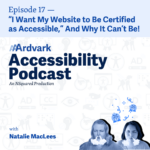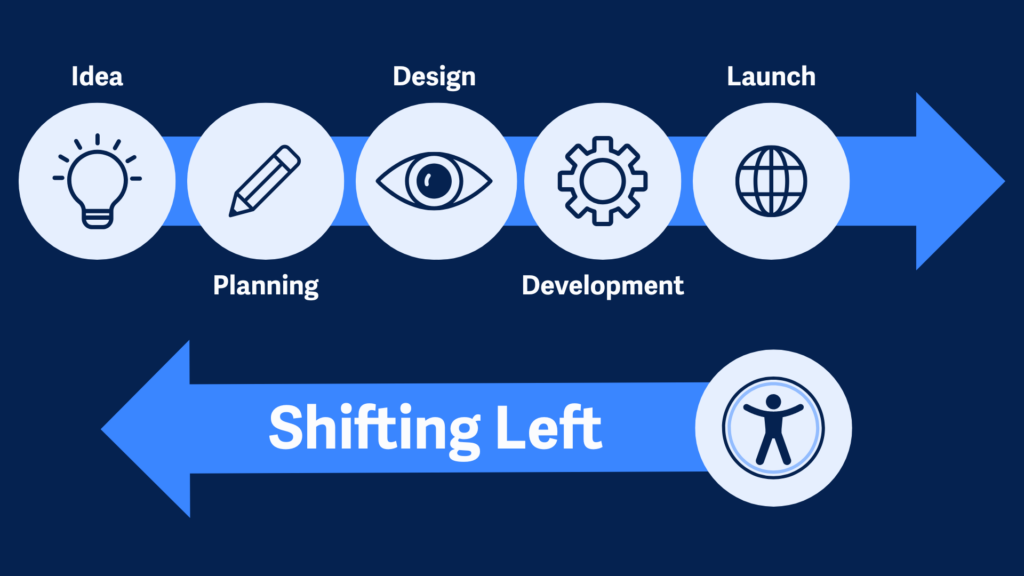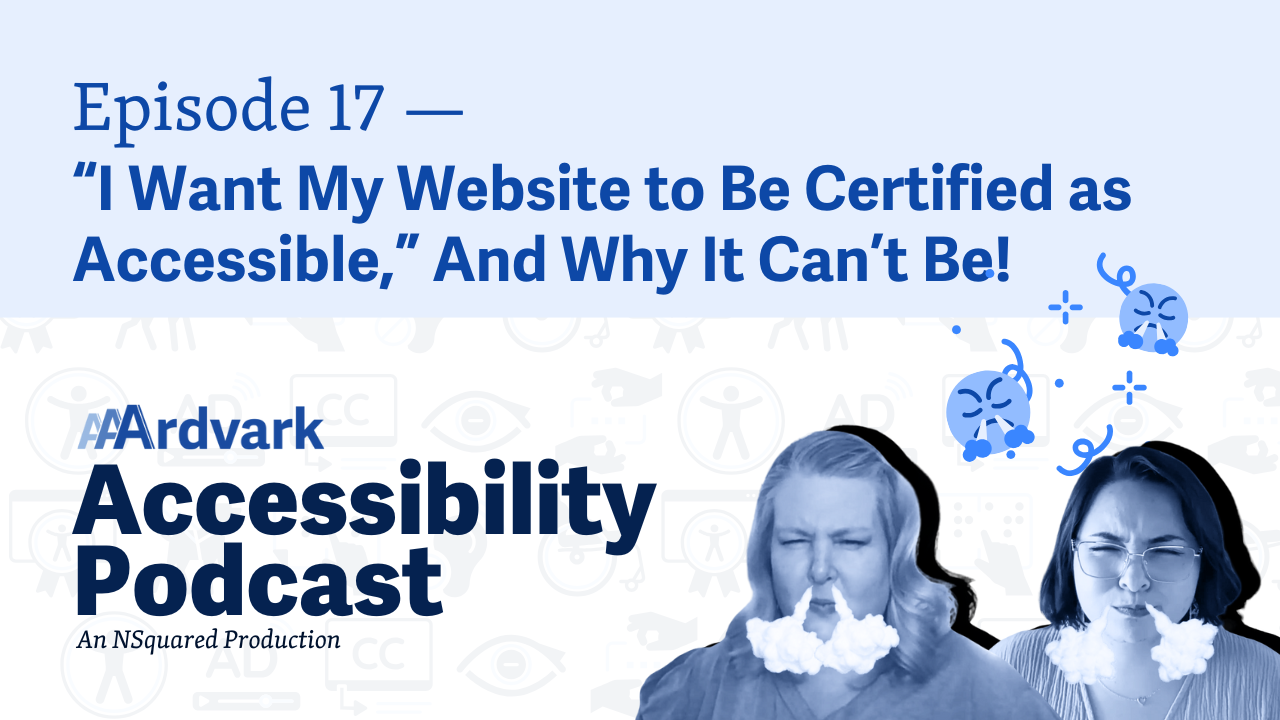
Join hosts Natalie MacLees and Natalie Garza on the 17th episode of the AAArdvark Accessibility Podcast as they discuss the misconceptions about website accessibility certifications and why they don’t exist.
Natalie Garza: Hello, everybody, and welcome to the AAArdvark Accessibility Podcast. This is episode 17. I’m Natalie G, the host and mic MC. And with me today is
Natalie MacLees: Natalie Mac, accessibility expert.
Natalie Garza: yes, she is an accessibility expert here to answer all our questions. And in today’s episode, we’re gonna talk about, “I wanna get my website or app certified as accessible.” Why can’t we get our website certified as accessible, Natalie?
Natalie MacLees: Yeah, this is something that clients often ask for more often than you might think because they want to have, I think they want two things. I think number one, they wanna have some kind of certification that they can display on the website to say, “Look, my website is accessible.” And then I think the second thing that they’re hoping to get is peace of mind, that nobody is going to be able to sue them or send them a demand letter saying that their website isn’t accessible.
And unfortunately there is no like official accessibility certification. We have talked extensively in other episodes of the podcast and I like all over online, if you could look up information on accessibility. You’ll see WCAG, the web content accessibility guidelines, referred to over and over again.
And those are just a set of guidelines. They’re not a certification scheme in any way, shape or form, and they’re also not comprehensive. So meeting WCAG does not mean that your website is a hundred percent accessible. It’s just a baseline of accessibility. So unfortunately, there is no way to actually certify a website as being accessible.
Natalie Garza: No, because accessibility is not a one-and-done kind of procedure.
Natalie MacLees: Yeah, that’s definitely one of the challenges because if, for example, there was some kind of website certification, you would have somebody come in, test your site, certify it as accessible, and then as soon as you went in and made one edit, that would be out the window. You would have to start all over again, and it wouldn’t be cheap, right?
It would be pretty time-consuming and pretty time-intensive. Websites change all the time, and it makes it really hard to have, you know, any report or anything that you do is just a point in time, right? On the day that this report was finished, here’s what the state of accessibility was on the site, but it is not
like a certification of that status, because probably maybe even that later, that same day, something on the website changed, something new was added, something was edited, something was removed, and now those test results are invalid.
Natalie Garza: Mm-hmm. Yeah. It’s like trying to certify a human is healthy,
Natalie MacLees: That’s a good analogy.
Natalie Garza: The next day, they can catch a cold. That certificate goes out the window.
Natalie MacLees: You might cut your finger, you might stub your toe
Natalie Garza: A Gator can bite your hand off.
Natalie MacLees: My goodness!
Natalie Garza: Sorry, Natalie just came back from Louisiana, you guys, Natalie came from Louisiana where she could have gone on the Gator tours, but she decided not to.
Natalie MacLees: Have both my hands, though.
Natalie Garza: Yes.
Natalie MacLees: I did not feed marshmallows and hot dogs to the alligators.
Natalie Garza: As fun as that sounds. She did not get to do that tour. Okay, so we can’t certify websites. We can only do reports which count for a certain point in time. Do you wanna touch on 508? Because there’s some, the word certification gets thrown in there with the certified trusted testers.
Natalie MacLees: Yeah, so the Department of Homeland Security in the United States does offer a certification course and test to anyone who’s willing to invest, I don’t know, a hundred hours of their lives, I suppose, into getting it. There’s no cost. And that is called the Section 508 Trusted Tester Program. And you can go through that program and learn all about web accessibility and how to test for it according to the Section 508 standards, which are similar to WCAG 2.1 AA, but not exactly the same.
And you can be certified as a tester to test for those guidelines. However, the test results that you produce, once you have that certification, those test results themselves are not certified in any way. And part of the reason for that is what we already touched on: websites change all the time, and you can produce
an ACR, an Accessibility Compliance Report based on the VPAT, the Voluntary Product Accessibility Template. But it’s just valid until you make a change on the website, basically. So if I were to finish an ACR today, and maybe you don’t make a change to your site for two days, well, we have two whole days that, that ACR is valid, and
then as soon as you make a change, it’s completely invalid again and would need to be redone. Now, that’s not reasonable. So most people don’t go through and do a whole ACR every time they edit something on their website. A lot of companies will set a cadence, which could be every six months, every year, or every two years, where they’re gonna come back and refresh that and catch up to where they are.
But again, it’s not a certification; it’s just a picture of how well the website is doing in complying with this standard on this day. And that’s all the more it’s doing. Yeah, so the accessibility testers, they tend to get certified, or they have the option to get certified in their practice. But even that, there’s no universal certification for testers either. Outside of that one, there’s nothing else. The IAAP has some certifications. We did an episode on it earlier, but they’re not; they don’t certify you to actually do work in the field. They’re just proof that you have a certain body of knowledge.
Natalie Garza: Yes. Yes. So if you hear the word certification around the accessibility, the digital accessibility space, there’s not too much to back it.
Whether you’re a tester or reporting something on a website.
Natalie MacLees: Yeah, that’s definitely a red flag that somebody is maybe doing something a bit untoward or inappropriate and making some guarantees that they can’t back up. So if somebody’s offering you a badge to display on your site or some kind of official certification, you should definitely be wary because that is not. It’s not likely to be legitimate.
Natalie Garza: Mm-hmm. Yeah, a site can never be a hundred percent accessible.
Natalie MacLees: That’s true. Even if you meet, you know, if you have to comply with Section 508, even if you meet it 100% and pass every single success criteria, or if you’re trying to comply with another standard, whether that it would be WCAG or if you’re in the EU, the EN 301549 standard, you can 100% comply with those standards and your website is still not 100% accessible because there are so many different parts of a website that can impact so many different kinds of audiences.
That you’ll just never get to 100% accessibility no matter how hard you try. Part of the challenge is that some of the needs of one group of people actually conflict with the needs of another group of people. And so you’re always trying to find the compromise there on how can we accomplish this feature or this content without setting up barriers.
For anybody, but there could still be some challenges that maybe somebody would have to deal with some inconveniences, or they might need to be a little bit tech savvy to be able to figure something out. So there’s always those kinds of challenges no matter how hard you try.
Natalie Garza: These are like the gray areas of accessibility.
Natalie MacLees: It’s the gray areas of accessibility and yeah, we have, our most recent blog post on our AAArdvark blog is actually about the things that you can do to help make your website accessible that are not in any guideline, just to give people examples of what kinds of things those are. So you could go and check that out if you’re curious.
Natalie Garza: And while you can’t get your website certified, it’s still nice to put up an accessibility statement.
Natalie MacLees: Yeah, absolutely. And an accessibility statement is also just a statement of, here’s what we have done to try to make our website accessible. Here’s where we know we have failed, and acknowledge that, and here’s who you can get in touch with if you’re running into a problem on the site so that we can try to address it.
Natalie Garza: So if we’re not trying to get our website certified. What should we be aiming for?
Natalie MacLees: Yeah, so aiming for meeting whatever compliance standard would apply to your website is always a good place to get started. Most websites do not comply with whatever standard would apply to them. So if you don’t have another legal standard where you are, then it’s pretty safe to say you should be trying for WCAG 2.2 AA. That would be every website on the web should be trying to comply with those things. So that’s a good place to get started is to try to conform with whatever the compliance rules are for where you are. And then from there, you wanna just be listening to your users, paying attention to where users might be running into problems.
Do user testing with your audience because every website’s audience is slightly different. And just be looking for ways that you can help to reduce friction and make using your website or your app or whatever you happen to be building digitally as accessible as possible.
Natalie Garza: And then also making changes to your workflow right now to slowly start incorporating better practices so that you don’t have to fix mistakes in the future.
Yes, and that is the practice that we call Shifting Left. I’ve never heard of that.
Natalie MacLees: Oh, we haven’t talked about Shifting Left. Okay. Yeah. Well, let’s talk about shifting left for a minute because you will see it pretty often in the accessibility world. You will see people give you the advice to Shift Left. And what that means is, I guess, if your language that you happen to speak is a left-to-right language like English, and you think of the process of making a website where you’re gonna have the initial idea, and then you’re going to do some sketches, wireframes, what have you, and then go to design, and then go to development, and then go to layering in functionality. And if you think of that as a linear process, that would go from left to right. Unfortunately, what a lot of people do is they insert accessibility at the end as the last step before launch.

Natalie Garza: That is not what we wanna do. You wanna move accessibility left in the process so that it’s earlier in the process. And ideally it should be in there right from the very beginning, like right from the point where you’re coming up with the idea and doing the initial sketches of the website. You should be thinking about accessibility there. Okay, so just thinking about accessibility earlier, “shift left” is not a keyboard command.
Natalie MacLees: It is not a keyboard command, and it is not a political statement.
Yeah, it just has to do with thinking about accessibility earlier in the process of planning and building a website or a digital product.
Natalie Garza: All right, so with that said, we talked about why you can’t certify your website to be accessible. We went over what you should actually be aiming for with your website if you want to start looking into making it more accessible. And now, where can people start? Where can website owners start if they want to make their websites more accessible?
Natalie MacLees: Yeah, you can come over to aaardvarkaccessibility.com and test out your homepage for free. No credit card is required. See where you might have some accessibility issues on your homepage, and it will guide you through explaining what those issues are and how you can fix them.
Natalie Garza: Perfect. So everybody go ahead over to aaardvarkaccessibility.com, get your website checked out or your homepage for free. Create a free workspace. And with that, we’ll end this podcast. This is episode 17. Thank you guys for joining us, and we’ll talk to y’all next time.

